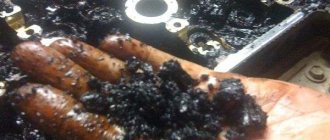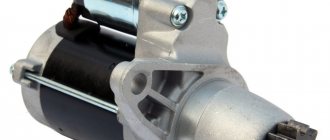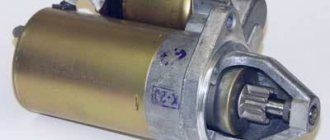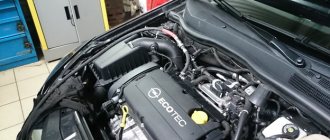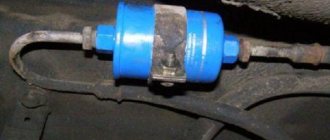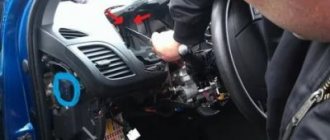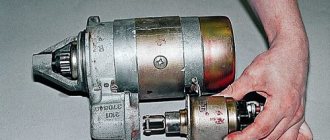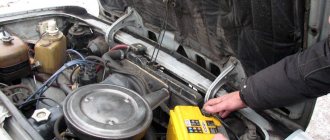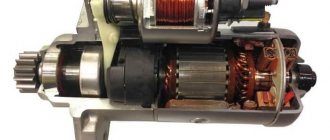At the moment the engine starts, the starter’s energy is spent not only on overcoming the resistance of the power unit, but also on its internal losses, which increase significantly if parts that constantly rub against each other are not lubricated. The starter requires regular seasonal maintenance, which includes both cleaning the old lubricant and applying new one.
What needs to be lubricated?
During the operation of the starter, problems arise that, although they occur for a fairly short time, are quite serious in their magnitude. When the starter gear engages the flywheel ring gear, a force is generated that acts transversely to the starter shaft.
This direction of load over time will lead to wear of the bushings, as a result of which they will acquire an ellipsoidal shape. At this time, the shaft shifts, which leads to an increase in the shaft gap between the gears, that is, the teeth begin to warp.
It is difficult for the starter to cope with such a load; the current consumed by them increases, which causes increased heating of the windings and power wires. In this case, the battery has a very difficult time. In particularly difficult cases, the wear of the bushings is so great that the starter is practically unable to rotate the crankshaft of the power unit and the battery discharges much faster. If unsuccessful attempts multiply significantly, then a complete discharge of the battery is not far off. If you are deprived of the opportunity to light your car from another or a charger, you will have to wait a very long time.
In addition, the battery plates may crumble, which means purchasing a battery. It turns out that you can simply destroy the most important part of the car, although not integrated, by your actions. You can extend the service life of the bushings and the entire battery, respectively, if you lubricate the starter in a timely manner. And this is within the capabilities of every car owner and there is no need to waste time or money on car mechanics.
It is necessary to lubricate not only the bushings, but also the starter shaft, so as not to impede the longitudinal movement of the overrunning clutch. And this is important in the case of a clutch wedge with a gear, because there is a possibility of teeth breaking. This can be determined based on the characteristic sound.
The starter device may contain a gearbox, or its mechanism may be devoid of it. The reducer serves to reduce the consumption of electric current from the battery. It is absolutely easy to disassemble it yourself. Almost the entire mechanism can be disassembled into spare parts. The gears of the gearbox provide resistance that is several times higher than that if there is no lubricant inside it, or it has become a very thick mastic.
As a rule, the starter should be diagnosed every 45,000 kilometers, otherwise you will cause trouble with your inaction. You can also lubricate the traction relay armature if it becomes rusty. First, its surface should be cleaned of corrosion until it is smooth. But, it is important to know one point: the lubricant should be applied in a very thin layer, so as not to impede its operation in very cold times and not make it a dusty magnet. So, from all of the above it follows that the following elements need to be lubricated:
— bushings;
— starter shaft;
— gearbox, if available;
- traction relay anchor.
Starter lubricant selection
The Internet is full of forums where disputes take place regarding which starter lubricant is best. The relevance of the issue arises if the starter has to be disassembled independently. If you leave this to the masters at the car service center, then you won’t have to choose. For those who still want to do this on their own, there are several variations:
- lithol;
— graphite lubricant;
- engine oil;
- castrol;
— cyatim-201;
- CV joint lubrication.
To choose the right lubricant option, you need to know its characteristics and scope of application. When the lubricant is exposed to low temperatures, it becomes very viscous, and at high temperatures there is a high probability of coking. Before you start lubricating the starter, you need to select a frost-resistant lubricant that retains its properties to the greatest extent.
Litol 24
It is fully functional in extreme temperature ranges from -40 to 120 degrees. Its viscosity ranges from 8 to 650 Pa-s. Can be applied to hinges and rubbing parts of electrical elements and mechanisms of a car.
Graphite grease
Its use is widespread in the temperature range from -20 to 70 degrees Celsius. Its viscosity is 100 pascals at an air temperature of 0 degrees. It is applied to parts that have been subjected to heavy loads, often the suspensions of tractors and cars.
Engine oil
It is better to use synthetic motor oil, because it is largely capable of maintaining its viscosity in low temperature ranges. It forms a fairly strong film on the surface of metal elements.
Castrol
Castrol LMX is lithium based. The temperature range is from -35 to 140. At 40 degrees Celsius, the viscosity is 83 Pascal.
Ciatim-201
Supplied as an oil thickened with lithium stearate. Used in temperature modes from -60 to 90 degrees Celsius. At a temperature of -50, its viscosity will already be 1100 Pascals.
CV joint lubrication
Used in a temperature range from -30 to 120 degrees. At a temperature of -30 degrees there will be 1800 Pascals. Used on constant velocity joints. When servicing the starter yourself, it is better to lubricate the shaft and journals; you can put Litol 24 or Castrol LMX in the gearbox.
At the same time, keep in mind that lubricant should be purchased only from trusted places, so as not to stumble upon counterfeits.
How should the starter be lubricated?
1. Put the transmission in neutral, squeeze the handbrake, and jam the wheels with boots.
2. Remove the terminal blocks from the battery.
3. Remove the air filter as a whole. The starter is located differently in different engines, but for the most part it is located to the left of the engine, when viewed from the hood.
We recommend: Inoperative window regulators: causes and solutions to the problem
4. Move the rubber fuse and unscrew the positive terminal.
5. Unscrew the nuts from the two studs with caps at “15” and remove the starter itself.
6. Proceed to disassembly once you have removed the assembly. Before placing it on the surface, thoroughly clean it to remove any remaining dirt or other debris. If there is such a need, then use kerosene, applying only locally.
7. Using the cap at “13”, remove the suction valve terminal block.
8. Unscrew the three bolts that secure the valve using a hexagon. It is likely that difficulties may arise, such as water and various weather conditions have already left their mark on them. Use WD-40 for this. If everything is already so tight, do not break it, otherwise the spitz will become unusable.
9. Take a drill and use a countersunk drill bit. Buy two studs marked M4x35 or, if possible, longer.
10. Using capes, unscrew the bolts and disconnect the two parts of the housing. Pry up the retaining ring on the rotor shaft, remove the thrust bushing, and remove the bendix. It may happen that you will need a metal shoulder that is slightly larger in diameter than the shaft in order to knock down the bushing.
It all depends on how great the degree of wear is.
11. A shaft, three gears and a gearbox open in front of you. Use a rag to remove any old grease and scrub them dry.
12. Apply a little lubricant, but you shouldn’t tamp it down, because too much of it and frost can lead to jamming.
13. Put on the gearbox cover and install the coupling, lubricating its splines with grease.
14. While you are assembling it, visually inspect the brushes. If wire burrs are visible, then replace the module.
15. Place the cover on the rotor shaft and lubricate it.
16. Lubricate the clutch just a little so that it fits easily into the groove of the crankshaft and screw in the studs.
17. After reinstalling the starter, put back the air filter.
18. Test the car.
Based on the operating instructions for your vehicle, it is necessary to carry out a technical inspection every 50,000 kilometers and change the lubricant. Depending on the conditions in which the vehicle was used, the interval may be reduced by three to four times. There can be two service options: fix everything yourself, or contact a service station for qualified repairs.
As can be seen from everything described above, the procedure does not require any complexity, but patience and certain skills for sure. Regarding the purchase of components and spare parts, it is recommended to purchase them only in specialized stores or dealership centers.
After all, with non-original products you doom the car and its components to subsequent early repairs. Well, the topic was sorted out step by step. I hope our advice will help you.
Starter lubrication: harm or benefit?
It is simply impossible to answer this question unambiguously, because what can harm some elements of the starter will be absolutely safe for other parts. Let's get to the bottom of this issue. Contrary to popular belief, lubrication of the anchor shaft in the area of the bendix stroke is mostly harmful than beneficial. Graphite lubricant accumulates dirt and dust in this place, and during prolonged inactivity of the car it can completely prevent the free movement of the bendix, as a result of thickening. Copper-graphite bushings on the armature axis also do not need lubrication, because their sliding is facilitated by graphite, which is powder-coated directly onto the bushings.
The only place where you can lubricate from the heart is the planetary gearbox. To better lubricate the gearbox, feel free to use WD-40. The most important thing is to monitor the general condition of the starter.
Subscribe to our feeds on social networks such as Facebook, Vkontakte, Instagram, Pinterest, Yandex Zen, Twitter and Telegram: all the most interesting automotive events collected in one place.
What needs to be lubricated
When the starter operates, loads arise that, although short-term, are quite large in magnitude. At the moment the starter gear engages with the flywheel ring gear, a force appears that acts transversely to the starter shaft.
This direction of the load over time leads to wear (abrasion) of the bushings, and they take on the shape of an ellipse. In this case, the shaft shifts and the gap between the gears increases, i.e., the teeth become misaligned. The starter has difficulty coping with such a load, the current it consumes increases, which causes increased heating of the windings and power wires.
In this case, the battery suffers. In particularly severe situations, the wear of the bushings is so great that the starter is practically unable to rotate the engine crankshaft, and the battery quickly discharges. Repeated unsuccessful attempts may result in almost complete discharge of the battery. If it is not possible to light a cigarette from another car or charger, then you will have to wait a long time.
In addition, the battery plates may crumble, which may result in the purchase of a new battery. It turns out that their unreasonable actions ruined him. You can extend the life of the bushings and, accordingly, the battery if you lubricate the starter in time. Anyone can do this with their own hands without visiting a car mechanic.
It is necessary to lubricate not only the bushings, but also the starter shaft so that the longitudinal movement of the overrunning clutch is not hampered. This is important because if the clutch and gear jam, there is a possibility of teeth breaking. This can be determined by the characteristic sound.
The starter can be either with or without a gearbox.
The gearbox allows you to reduce current consumption from the battery. It is not difficult to disassemble it with your own hands. Almost the entire starter can be scattered into spare parts. The presence of gears in the gearbox creates resistance, which is much greater when there is no lubricant inside or it has turned into a very thick mastic.
Gearbox lubrication
As a rule, you need to pay attention to the starter once every 45,000 km, otherwise your actions (or inaction) can lead to trouble.
You can also lubricate the traction relay armature if it is rusty. Before doing this, accordingly, clean its surface from corrosion so that it becomes smooth. But, it is advisable to leave this part without lubrication or apply it in a very thin layer, so as not to impede movement at low temperatures and not to become a dust collector.
We recommend: Caution: painted! Preparatory work and organization of make-up
So, during maintenance you need to lubricate with your own hands:
- Bushings;
- Starter shaft;
- Gearbox (if any);
- Traction relay anchor.
Review Reviews
The instructions for the vehicle indicate that its technical inspection is necessary after every 50,000 km. Then you need to lubricate the starter bearings.
It is important to take into account the specific conditions in which the vehicle was operated. To service your car, you can use your own strength or contact a car service center.
Knowing which lubricant to choose for a car starter, having studied the stages of performing such work, it will not be difficult to complete them. You just need to be patient and have some knowledge.
If you need to use spare parts and components, it is better to choose them from reliable suppliers. Cooperation with dealer centers is also practiced. The use of non-original parts and components often leads to the need for early repairs.
Starter lubrication
At the moment of engagement with the flywheel gear, the Bendix experiences large lateral loads. There is a gradual displacement of the shaft, wear of the drive bushings, and an increase in the gap between the teeth of the bendix and the rim. There is a need to lubricate the bushings and starter shaft in order to facilitate the movement of the overrunning clutch.
Lubrication of starter elements
It is advisable to apply a thin layer to the anchor or traction relay if there are traces of corrosion on it.
The drive bushing, shaft, and relay armature are lubricated. If the starter is equipped with a gearbox, then its gears are coated with oil. The lubrication procedure can be performed by the driver's hands.
What to lubricate with (choice)?
Bendix starter from a different angle. Signs of wear are practically invisible.
Related to the application and characteristics of the lubricant. The lubricant should not lose its viscosity at sub-zero temperatures and not coke in hot weather. That is, frost-resistant lubricants are selected, which include:
- Motor synthetic . Retains viscosity properties at low temperatures with a long period of retention of the oil coating on moving, rotating joints.
- CV joint lubrication. Used in constant velocity joints of off-road vehicles (4x4), (6x6). The properties of the oil are maintained at −30+90°C. This is a plastic, mineral substance mixed with lithium soap and additives. Can be used at −40+120 °C. For example, CV joints differ from CIATIM-201 in so-called tribological properties.
CV joint grease can be used to lubricate Bendix
This means that the lubricant counteracts the appearance of scuffing and burrs on the body of rubbing parts. That is, under excessive load, the Bendix gear, pressing strongly against another similar part, squeezes out the oil film. This fact leads to hard lapping, creating scuffing on the metal up to friction welding. In our case, CV joint-4 can be replaced with LITOL-24, which has higher lubricating properties.
- Castrol. Available with a lithium component. The temperature range is −35+140°C, with a relatively low viscosity value. Includes fuel additives, transmission oils, and greases.
Castrol lithium grease
- Graphite . Used in units operating under excessive loads within the temperature range of −20+70°C. Lubricants with a cooling temperature of −15°C are considered summer, and −20°C winter. It has anti-friction properties and improved lapping of joints. Calcium additives as additives are resistant to being washed away by jets of water.
- Bendix lubricant belongs to the category of gear oils. By the way, it is advisable not to lubricate the starter shaft and splined part. The point is that they must be in a dry, clean state. Since the metal-brass pair is designed for better sliding, the bendix bushing and armature can be coated without risk with a thin layer of CIATIM-201 .
- Litol is a multi-purpose, frost-resistant, waterproof, lithium grease. It is used in transmission units not only of vehicles.
LITOL lubricant
Operating temperature range, for example, CIATIM 201 −60+90°C. It is used in worm and gear drives, rolling and sliding bearings, and friction units.
Top motor oils
Engine oil is the lubricant used to lubricate the starter. Let's look at the top best tools for this purpose:
- Mobil 1 is a leading player in the synthetic oil industry for safety reasons. The oil provides lubrication as well as protection to the gearbox, a vital component for high mileage vehicles. By using this product exclusively, the driver preserves car parts for longer use.
- Liqui Moly Premium 5W-40 is a synthetic oil that offers complete engine and gear protection for all types of vehicles and is a proven solution for motorists living in regions with low temperatures. Liqui Moly provides excellent engine cleanliness and ultra-high wear protection. This German-made fully synthetic oil ensures the longevity of your car parts as it does not impair their performance even in cold temperatures.
- Shell Rotella T6 is one of the most powerful synthetic diesel motor oils available on the market. This is because it provides improved fuel efficiency of 1.5% without compromising engine protection. In addition, it provides significantly increased levels of protection against engine wear damage compared to earlier generation CJ-4 engine oils. Its triple protection formula blends fully synthetic base oils with advanced multi-function additives for superior equipment protection and extended engine life.
List of tools required for repair
To repair a starter, approximately the same set is required, depending on the model and manufacturer of the unit. The table below provides an indicative list of tools that will be needed for repairs.
Table - Tools required to replace the front strut
| Name | Note |
| TORX head | Required mainly when repairing starters from foreign cars |
| Head | “at 8”, “at 10”, “at 12”, “at 13”, “at 14”, “at 15”. Size varies depending on the make and model of starter. |
| open-end wrench | For access where a socket or spanner cannot reach |
| Vorotok | With ratchet and extension |
| Multimeter | To check the electrical parameters of the starter |
| Cardan for wrench | Required if access to the starter or wire mounts is difficult |
| Screwdriver | With flat or cross blade. On foreign cars, a specially shaped tip is sometimes required, for example, flat with a notch or an “asterisk” |
| Insulating tape | To restore insulation |
| Penetrating lubricant | For loosening stuck threaded connections |
| Rags | For cleaning dirt and grease residues |
In order to repair a faulty starter, it is recommended to purchase a special repair kit. It includes the main elements of the assembly that are most susceptible to wear. Sometimes such a repair kit includes some of the tools necessary to restore the functionality of the unit.
Possible causes of bendix malfunction
Lada Kalina Sedan my first car Logbook Phase sensor
Replacing the starter bendix is not a cheap job, and the unit itself can cause serious damage to the car owner’s budget. By repairing or replacing it yourself, you can avoid high costs.
The main causes of malfunctions affecting the reliable adhesion of the flywheel and overrunning clutch of the car starter include:
- Formation of deposits inside its body;
- Weakening or breaking of the overrunning clutch roller springs;
- Hull destruction;
- Roller wear.
Some of these faults can be eliminated by repair work; to eliminate others, it will be necessary to replace the starter bendix.
In some cases, repairs come down to soaking the front part of the starter in a container of gasoline and then drying it. Often, after such a procedure, the Bendix Ford Fiesta came into working condition and was not bothered by malfunctions for a long time. In this case, car owners did not even have to think about how to remove the bendix from the starter and put it back.
The best starter lubricant
We will try to systematize the information and provide you with a table that provides information on which lubricant is best to use for the planetary starter gearbox, as well as its shaft. We are not trying to impose our vision, but only present the information that we managed to find.
| Lubrication units | Lubricant requirements | Examples of lubricants |
| Planetary reductor | Long-lasting, compatible with plastic parts and elastomers, resistance to high mechanical loads, wide operating temperature range |
|
| Starter shaft | Providing low friction coefficient, high load-bearing capacity, liquid resistance and corrosion protection, wide temperature range. |
|
| Overrunning clutch | Wide temperature range, compatibility with various machine couplings, resistance to oxidation and humidity, protection against corrosion of working surfaces, long-term use. |
|
Surely, based on the information provided, it will be easier for you to make your choice. After all, there are a lot of opinions on the use of certain lubricants on numerous forums. There are also differing opinions regarding the general advisability of lubricating individual starter components. Let's talk briefly about this below.
"Litol"
Litol 3 is a highly effective multi-purpose lubricant, blended using modern processing technology. Litol can be used for ball bearings, roller bearings, metal joints such as steel, in mining, quarries, agriculture, construction and general industrial applications.
This type of car starter lubricant is produced with high quality additives as anti-corrosion, anti-oxidation, adhesive agents and a special lithium thickener, which provides:
- Effective corrosion inhibitors and protects metal surfaces.
- Well protects against oxidation, ensures long service life of the starter.
- Excellent wear protection.
- Wide operating temperature range from -10 ºC to 140 ºC.
What to lubricate
You can find many forums on the Internet where they argue about which lubricant is best for the starter. The question of its choice is relevant if you disassemble the starter yourself. If a car service does this, then you don’t have to choose.
For those who want to do it themselves, there are several options:
- Litol;
- Graphite;
- Engine oil;
- Castrol;
- Cyatim-201;
- CV joint lubrication.
Bendix, starter drive shaft
In order to choose the right lubricant option, you need to know the characteristics and scope of application. At low temperatures, the lubricant loses its properties, becomes more viscous, and at high temperatures it can coke. Before you start lubricating the starter, you need to select a frost-resistant product based on its characteristics that will best preserve its properties.
Litol 24
Operable in the range from -40 to 120 degrees. Viscosity from 8 to 650 Pa-s. The area of application includes hinges and friction parts of electrical machines.
Graphite grease
It is used in the temperature range from -20 to 70 degrees. Its viscosity is 100 Pa-s at zero air temperature. It is used in parts subject to heavy loads, mainly car and tractor suspensions.
Engine oil
When using motor oil, it is better to use synthetic oil, since it largely retains its viscosity at low temperatures. It forms a fairly strong film on the metal surface.
Castrol
Castrol LMX is lithium based. Temperature range from -35 to 140. Viscosity at 40 degrees is about 83. Used in heavily loaded units.
Ciatim-201
It is an oil thickened with lithium stearate. Used at temperatures from -60 to 90 degrees. The viscosity already at -50 will be 1100 Pa-s.
CV joint lubrication
Temperature range of use is from -30 to 120 degrees. Viscosity at -30 will be 1800 Pa-s. Application area: constant velocity joints.
When servicing the starter with your own hands, it is best to lubricate the trunnions and shaft with engine oil; you can put Litol 24 or Castrol LMX in the gearbox. At the same time, keep in mind that you need to buy lubricant in trusted places to avoid counterfeits.
The use of lubricants in friction units and starter mechanisms
Repairing defects in individual parts (several) is not advisable from the point of view of the unpredictability of high-quality work. Replacing the starter with a new one will avoid headaches for many years. When replacing worn ones, give preference to parts from well-known manufacturers.
At the moment of starting, the starter’s energy is spent not only in overcoming the resistance of the motor, but also on its internal losses, which increase significantly if the rubbing parts are not lubricated. The starter requires seasonal maintenance (STO), which includes cleaning the old lubricant and applying new lubricant.
Having decided which lubricant can be chosen for a car starter, let’s consider the features of its use.
Required tools:
- keys (7 mm, 8 mm, 10 mm);
- keys (3 mm, 4 mm, 5 mm, 6 mm);
- torque wrench 0-20 inches;
- silicone gasket (maximally resistant to oil);
- shaft seal lubricant;
- dielectric or conductive grease for motor terminals;
- towel;
- razor blade or sharp plastic scraper;
- tool for removing the generator cover;
- engine oil;
- coolant.
Starter design
Dismantled “crispy” starter bendix
The brand depends on the purpose, characteristics, and function of the starting motor. Receiving power from the battery, the starter rotates the engine crankshaft. Structurally consists of nodes:
- Brush (commutator) motor.
- Bendix is a gear driven mechanism (overrunning).
- Traction relay.
This is the main unit of the electrical system that produces series excitation. That is, the starter is the main component of starting a car engine.
The main and only source of energy is the battery , which powers all electrical appliances while the machine is inoperative.
Small in size, but high in power, the starter is designed for easy starting and operation of a car in low temperatures.
How does a car start?
Not enough lubrication in Bendix
Turning the ignition key closes the contact bolts of the starter. Acting on the relay armature (traction) through the lever, the drive coupling is driven, which, by moving the gear, engages the flywheel rim.
The electrical circuit and the bendix are closed, causing the flywheel and crankshaft to rotate. Next, the piston group works, igniting the fuel mixture.
This completes the starter function, returning to the starting position. That is, the drive disengages from the ring, but the engine continues to operate. Cars with automatic transmission are equipped with a starter retaining coil, which allows the engine to start only if it is in the neutral position of the gear lever or the “P” position.
Let's sum it up
The article discussed the question of what lubricant to lubricate the starter. When this mechanism works, its gear goes inside the flywheel. This results in a force acting on the transverse direction of the starter shaft. And as a result of long-term use, the parts that take part in this process are subject to severe wear when the bushing takes the shape of an ellipse. Then the shaft begins to shift and the gap between the parts becomes larger. As a result of such changes, tooth misalignment occurs.
Since difficulty arises in the operation of the starter, the current also increases. The winding and power wires become hot. The battery suffers from this. Due to severe wear, the starter has difficulty turning the crankshaft. And if you don't take action, the battery will be completely discharged.
To prevent the occurrence of such difficulties, it is recommended to take care of the condition of the starter. It is important to lubricate it. The frequency of such actions is every 50,000 km.
Experts believe that not all starter parts need to be lubricated, but only the planetary gear part. You can carry out this process yourself or use the services of a car service center. Timely lubrication will prolong the performance of the starter mechanism and battery.
Brush unit
To access the brush assembly, the starter must be disassembled as shown in the image below.
The first thing you should check is how the brushes move in the brush holders. If there are jams, the defective areas should be sanded.
Brushes need to be inspected for melting and thermal damage. Particular attention must be paid to the point of contact with the collector. Minor defects can be removed by sanding.
During operation, the brushes wear out. The critical size ranges from 4 mm to 15 mm depending on the design. If this is achieved, the brushes need to be replaced. Their price ranges from 90 to 1800 rubles, depending on the brand and model of the starter.
So does the starter need to be lubricated?
On numerous forums on the Internet, there are different opinions on whether certain parts of the starter need to be lubricated. It’s worth saying right away that the planetary gearbox can be generously lubricated. By doing this you will only contribute to its normal operation. For this purpose, it is better to use: from expensive lubricants LIQUI MOLY Thermoflex or RAVENOL Arctic Green Grease AGG2, from cheap ones - “Litol 24”, graphite lubricant, CV joint lubricants. Also, the choice should be based not only on price, but also on operating temperature.
As for the gearbox shaft, it is better to use the above-listed Molykote 3400A Leedfree, Molykote BR 2 Plus, graphite lubricant, Castrol LMX, Ciatim 201. The choice again depends on price and temperature conditions.
Some car enthusiasts use WD-40 as a lubricant. However, we do NOT recommend that you do this, since this product is not inherently a lubricant and can damage the starter elements.
There is an opinion that it is necessary to lubricate the copper-graphite bushings on the armature axis. Actually this is not true! Their normal sliding is facilitated by graphite, which is powder applied to their working surface. As you know, graphite is excellent for gliding. At the same time, dirt does not accumulate on it.
Regarding the question of how to lubricate the starter solenoid relay and its armature, there is a recommendation not to lubricate it at all. The fact is that the lubricant in this place collects various dirt on itself, forming a dense mud layer, which undoubtedly harms the normal operation of the Bendix. And if this same lubricant thickens in the cold, then this will be all the more harmful for the mentioned elements of the starter and threatens emergency operation until it completely fails.
What's the result?
Thus, the selection of lubricant for the starter largely depends on the operating conditions of the machine. In particular, it depends on the frost in which she drives. The main thing is that the lubricant is always of normal consistency. Also, do not forget to do a preventive inspection of the starter every 40...50 thousand kilometers or every 2 years and lubricate its shaft and planetary gearbox. But lubricating the shaft where the bendix moves or the solenoid relay not only makes no sense, but is also harmful. Copper bushings are also included in the list of non-lubricated parts, but are only subject to wear control.
How to do it
- We put it in neutral, squeeze the handbrake, wedge the wheels with shoes;
- We remove the terminal blocks from the battery;
- We remove the air filter as a whole;
- Different engines have different starter locations, but most will have it to the left of the engine when looking at it from the hood. We move the rubber fuse and unscrew the positive terminal;
- Using “15” caps, unscrew the nuts from the two studs. We remove the starter itself directly;
When we have taken out the assembly itself, we now move on to disassembling it:
- Before placing it on the table surface, carefully clean it from any remaining dirt and other formations. If necessary, you can use kerosene (but only locally);
- Use the cap on “13” to remove the terminal block of the suction valve;
- Using a hexagon, unscrew the three bolts that secure the valve. There may be difficulties, since water and weather conditions have already left their mark on them. Use "VD-40". If it’s really tight, don’t break it, otherwise the splines will be in trouble. Take a drill and drill out with a countersunk drill bit. It will be necessary to purchase two additional studs marked M4x35 or longer;
- Using capes, unscrew the bolts and disconnect the two parts of the body;
- Use a screwdriver to pry up the retaining ring on the rotor shaft, remove the thrust bushing, and remove the bendix (clutch). You may need a metal arm slightly larger in diameter than the shaft to knock down the bushing. It all depends on the quality and degree of wear;
- Before us is a shaft, 3 gears and a gearbox. Using a rag, remove old grease and wipe dry;
- Apply a small amount of grease to the bearings, which was indicated at the beginning of the article. You should not tamp, as excessive amounts and frost can cause a wedge;
- We put on the gearbox cover and install the bendix, having previously lubricated its splines with grease;
- During assembly, we carry out visual diagnostics of the brushes. If wire kinks are visible, it is better to replace the module assembly;
- We put a cover on the rotor shaft and lubricate it with grease;
- Lubricate the Bendix quite a bit to make it easier to fit into the crankshaft groove, screw in the studs;
- After the starter is installed, return the air filter;
- We test the car.
According to the requirements of the vehicle operating instructions, a technical inspection must be carried out every 50,000 km.
mileage and change the lubricant. Depending on the conditions of use, the interval can be reduced by 10-15 thousand km. mileage There are two service options: do it yourself on your own or take it to a car service center for work.
As you can see, the procedure is far from complicated.
, but you should still have patience and certain skills. As for the procedure for purchasing spare parts and components, it is recommended to purchase them only from certified auto stores or dealerships. Since by buying non-original products you are dooming the car and its components to another early repair. Well, we’ve sorted out the topic of how to lubricate a car starter step by step, I hope our tips will help many car enthusiasts.
mileage and change the lubricant. Depending on the conditions of use, the interval can be reduced by 10-15 thousand km. mileage There are two service options: do it yourself on your own or take it to a car service center for work. As you can see, the procedure is far from complicated, but you should still have patience and certain skills.
As for the procedure for purchasing spare parts and components, it is recommended to purchase them only from certified auto stores or dealerships. Since by buying non-original products you are dooming the car and its components to another early repair. Well, we’ve sorted out the topic of how to lubricate a car starter step by step, I hope our tips will help many car enthusiasts.
